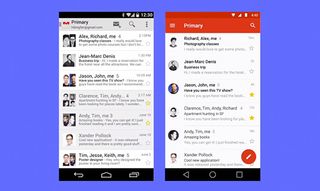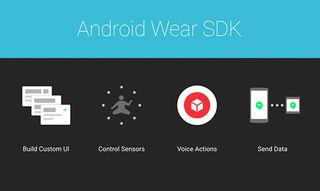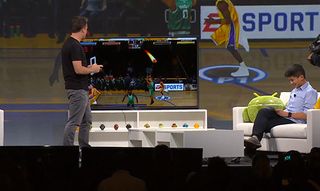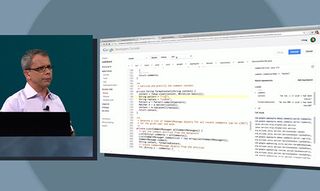Google I/O: the 8 biggest announcements that impact developers
AnalogFolk's Ian Brennan on the big announcements from Google's annual developer conference, and what they mean to you.
Google I/O kicked off last night with a three-hour keynote presented by a number of senior figures from the tech giant. Traditionally the event has always been focused on developers, but more recently Google has used it as a platform to launch new products into the consumer space. This year was no exception, so let's take a look at the biggest announcements and how they'll impact developers.
01. Android L
The Keynote was packed full of surprises, and it all began with the announcement of the next version of Android. Following their sequential lettering naming system, the next version of Android is code named 'L', moving on one letter from 'K' (KitKat) of course.
After Sundar Pichai - Senior Vice President of Android, Chrome & Apps - had finished telling the room that Android users take 93 million selfies a day, he unveiled an initiative called Android One. Google has designed the initiative to support manufacturers and help make it easier for them to build cheaper, lower spec, handsets for emerging markets. It's the result of the ongoing optimisation of Android OS, and will open up developers to the 90 per cent of mobile users in emerging markets who don't yet have a smartphone.
Android L packs a load of new features, but perhaps the most interesting for developers is Google's intent on unifying the design language and experience across multi-platform applications. To support this, they've launched something called 'Material Design'.
02. Material Design
There is a saying, "Google is getting better at design faster than Apple is getting better at software development". This new way of thinking, called 'Material Design', is a way to really feel connected with the interface.

Drawing inspiration from paper and ink, Material has been designed to to give users feedback through the subtle visual differences between surfaces of an application. Things hover, have depth, snap into place, and are colourful.
Last year at Google I/O, Polymer was announced, a set up tools to make development of web applications across desktop, tablet, and mobile a lot easier. Polymer now includes Material Design, and Google has uploaded some examples to show it off. One of the nicest examples is this beautifully animated, colourful, and responsive Quiz App.
Get the Creative Bloq Newsletter
Daily design news, reviews, how-tos and more, as picked by the editors.
Google has put together a comprehensive set of guidelines, tools, and discussion groups to make the implementation of Material Design easier for developers. You can find it here.
03. Android Wear
Announced a few months ago, Android Wear is Google's big push into the wearables market. At I/O yesterday we got to learn a lot more about the new platform, and most importantly that they've opened up the Android Wear SDK to developers.
This moves Android Wear on from the Developer Preview that was launched in March, and allows developers to now start writing code that runs directly on the device itself. You can create fully customised UI's, read sensors, listen for voice actions, and much more.

This announcement received some big cheers from the audience at the Keynote, and was followed by a demo showing an app that allows you to order a pizza straight from your wrist in under 20 seconds. If that's not the future, I don't know what is!

Once Google I/O has finished, the Android Wear SDK and accompanying documentation will be available from here.
04. Android Auto
In its simplest terms, Android Auto is a screencasting utility that mimics UI elements and functionality straight on to your in-car screen. In reality it's a lot more than that. Google put a lot of effort into making the experience seamless.
The on-stage demo involved the user asking Google how long a museum is open for, receiving the answer through his car speakers, and then asking to be taken there. Up popped Google Maps, with real time traffic information, and away he went. During that demo, he pressed one button on the steering wheel, the rest was done through voice controls.
It's an impressive offering, and something that's competing directly with the Apple CarPlay system. It's too early to say which system will prove most popular with consumers, but with Google's ever increasing share of the mobile market it's likely they'll be the early leaders.
Google has released an Android Auto SDK, which opens up the in car messaging ability to third party applications.
05. Android TV
TVs are fast becoming smarter and more connected. Google has recognised that the TV marketplace is similar to that of mobiles in 2006 - it's fragmented with little consistency between manufactures and their software.
The live demo involved one user playing a game on their tablet, while the other played on their TV with a controller in a multiplayer game together. It was seamless, and showed the potential of being able to use Android Apps directly on your TV.

Google was clear to point out that Android TV isn't a new platform, but rather an extension of their mobile and tablet OS. This is great news for developers. Google has recognised that creating apps using one unified SDK makes life a lot easier. You can now build applications for mobile, tablet, watch, car, and TV using one SDK. Awesome.
06. Workplace
With the release of Android L, Google is unifying the corporate vs personal mobile phone dilemma. Google's vision is to allow users to carry just one device around, and use it for both work and pleasure with some clever data separation and security measures.
One of the most interesting changes comes in the way applications are deployed to many devices. Google will allow companies to buy applications in bulk, and deploy directly to the staff members handset. Developers don't need to modify anything within their existing app to do this, Google handles everything from its side.
There was a surprise announcement in this part of the Keynote, that Samsung has contributed all the work it has done on Knox to the Android platform. Perhaps it's a sign of the two tech giants unifying, and trying to tackle Apple, Microsoft and others as a single powerhouse.
07. Google Cloud Platform
Google presented really interesting case studies for its Google Cloud Platform service. Secret, an application that allows you to speak anonymously with your friends, was built and scaled with only one backend developer. It's had 1000x growth in daily active users.
At this point, the presentation was awkwardly interrupted by a protester who insisted Google was building killer robots and were an evil the world has never seen before.
Swiftly moving on from that interruption, we were presented with some live coding, which didn't go as smoothly as the presenter would have liked. Eventually, using the Google Developers Console, we were shown how to live debug across multiple servers and instances.

Another new feature of the platform is called Cloud Tracing, which allows you to trace your queries and filter them based on your criteria. The queries can be expanded, and analysed to work out where your application slowdowns are being introduced. Cloud Tracing also generates reports, which are visually similar to Google Analytics, but they let you compare things like latency before and after live deployments.
It was a mightily impressive set of tools for developers, and you can read about them in more detail here.
08. Glass and Plus
This one isn't really an announcement, but it's probably more interesting from the silence. Neither Google Glass or Plus were mentioned during the keynote. None of the presenters wore Google Glass, and even when the discussion turned to wearables and watches Google opted not to mention their 'vision' for the future.
Instead of Glass, Google announced a hack VR headset called Cardboard. It was created by some engineers in their downtime, and turns your Android handset into a raw VR headset. Was it a cheap shot at Facebook and the $2billion Oculus Rift purchase? Maybe.
Google+ is probably suffering from a lack of direction since Vic Gundotra, the one many credit for inception of the service, left the company. Some analysts predict that Google+ is going through a transition into separate standalone services, rather than being a flagship product at the forefront of Google's public operations.
Perhaps the absence of Glass has something to do with the aforementioned protester. Google has come under a lot of fire about Glass, and the camera which many claim invades privacy. It's been somewhat of a PR disaster at times, and maybe moving it out of the spotlight for a while is a smart move.
Words: Ian Brennan
Ian Brennan, Head of Technical Concepting at AnalogFolk London, leads a team of developers in prototyping, innovation, and creativity. He also organises developer meetups, hack days, and demo sessions to showcase new technologies.

Thank you for reading 5 articles this month* Join now for unlimited access
Enjoy your first month for just £1 / $1 / €1
*Read 5 free articles per month without a subscription

Join now for unlimited access
Try first month for just £1 / $1 / €1
The Creative Bloq team is made up of a group of design fans, and has changed and evolved since Creative Bloq began back in 2012. The current website team consists of eight full-time members of staff: Editor Georgia Coggan, Deputy Editor Rosie Hilder, Ecommerce Editor Beren Neale, Senior News Editor Daniel Piper, Editor, Digital Art and 3D Ian Dean, Tech Reviews Editor Erlingur Einarsson, Ecommerce Writer Beth Nicholls and Staff Writer Natalie Fear, as well as a roster of freelancers from around the world. The ImagineFX magazine team also pitch in, ensuring that content from leading digital art publication ImagineFX is represented on Creative Bloq.
